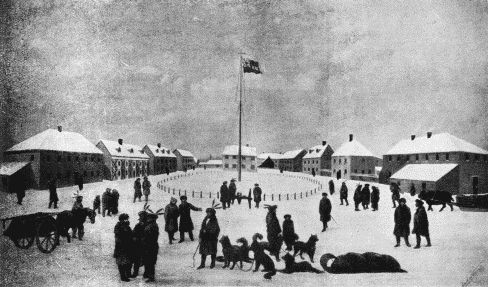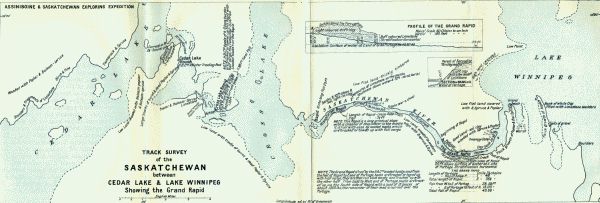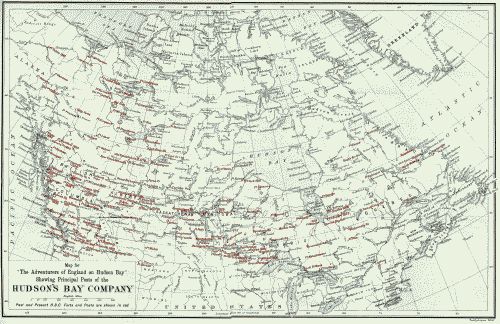Canadian
Research
Alberta
British
Columbia
Manitoba
New Brunswick
Newfoundland
Northern
Territories
Nova Scotia
Nunavut
Ontario
Prince Edward
Island
Quebec
Saskatchewan
Yukon
Canadian Indian
Tribes
Chronicles of
Canada
Free Genealogy Forms
Family Tree
Chart
Research
Calendar
Research Extract
Free Census
Forms
Correspondence Record
Family Group Chart
Source
Summary New Genealogy Data
Family Tree Search
Biographies
Genealogy Books For Sale
Indian Mythology
US Genealogy
Other Websites
British Isles Genealogy
Australian Genealogy
  
FREE Web Site Hosting at
Canadian Genealogy
|
The Fur Hunters
Thirty or more years ago, one who stood at the foot
of Main Street, Winnipeg, in front of the stone gate leading to the
inner court of Fort Garry, and looked up across the river flats,
would have seen a procession as picturesque as ever graced the
streets of old Quebec—the dog brigades of the Hudson's Bay Company
coming in from the winter's hunt.
Against the rolling snowdrifts appeared a line, at first grotesquely
dwarfed under the mock suns of the eastern sky veiled in a soft
frost fog. Then a husky-dog in bells and harness bounced up over the
drifts, followed by another and yet another—eight or ten dogs to
each long, low toboggan that slid along loaded and heaped with
peltry. Beside each sleigh emerged out of the haze the form of the
driver—a swarthy fellow, on snow-shoes, with hair bound back by a
red scarf, and corduroy trousers belted in by another red scarf, and
fur gauntlets to his elbows—flourishing his whip and yelling, in a
high, snarling falsetto, 'marche! marche!'—the rallying-cry of the
French wood-runner since first he set out from Quebec in the
sixteen-hundreds to thread his way westward through the wilds of the
continent.
Behind at a sort of dog-trot came women, clothed in skirts and
shawls made of red and green blankets; papooses in moss bags on
their mothers' backs, their little heads wobbling under the fur
flaps and capotes. Then, as the dog teams sped from a trot to a
gallop with whoops and jingling of bells, there whipped past a long,
low, toboggan-shaped sleigh with the fastest dogs and the finest
robes—the equipage of the chief factor or trader. Before the
spectator could take in any more of the scene, dogs and sleighs,
runners and women, had swept inside the gate.

A View Of The Interior Of Old Fort Garry
Drawn by H. A. Strong
At a still earlier period, say in the seventies, one who in
summer chanced to be on Lake Winnipeg at the mouth of the great Saskatchewan
river—which, by countless portages and interlinking lakes, is connected with all
the vast water systems of the North—would have seen the fur traders sweeping
down in huge flotillas of canoes and flat-bottomed Mackinaw boats—exultant after
running the Grand Rapids, where the waters of the Great Plains converge to a
width of some hundred rods and rush nine miles over rocks the size of a house in
a furious cataract.
Summer or winter, it was a life of wild adventure and daily romance.
Here on the Saskatchewan every paddle-dip, every twist and turn of the supple
canoes, revealed some new caprice of the river's moods. In places the current
would be shallow and the canoes would lag. Then the paddlers must catch the veer
of the flow or they would presently be out waist-deep shoving cargo and craft
off sand bars. Again, as at Grand Rapids, where the banks were rock-faced and
sheer, the canoes would run merrily in swift-flowing waters. No wonder the
Indian voyageurs regarded all rivers as living personalities and made the River
Goddess offerings of tobacco for fair wind and good voyage. And it is to be kept
in mind that no river like the Saskatchewan can be permanently mapped. No map or
chart of such a river could serve its purpose for more than a year. Chart it
to-day, and perhaps to-morrow it jumps its river bed; and where was a current is
now a swampy lake in which the paddle men may lose their way.
When the waters chanced to be low at Grand Rapids, showing huge rocks through
the white spray, cargoes would be unloaded and the peltry sent across the
nine-mile portage by tramway; but when the river was high—as in June after the
melting of the mountain snows—the voyageurs were always keen for the excitement
of making the descent by canoe. Lestang, M'Kay, Mackenzie, a dozen famous
guides, could boast two trips a day down the rapids, without so much as grazing
a paddle on the rocks. Indeed, the different crews would race each other into
the very vortex of the wildest water; and woe betide the old voyageur whose crew
failed of the strong pull into the right current just when the craft took the
plunge! Here, where the waters of the vast prairie region are descending over
huge boulders and rocky islets between banks not a third of a mile apart, there
is a wild river scene. Far ahead the paddlers can hear the roar of the swirl.
Now the surface of the river rounds and rises in the eddies of an undertow, and
the canoe leaps forward; then, a swifter plunge through the middle of a furious
overfall. The steersman rises at the stern and leans forward like a runner.

Track Survey Of The Saskatchewan
Between Cedar Lake & Lake Winnipeg
'Pull!' shouts the steersman; and the canoe shoots past one rock
to catch the current that will whirl it past the next, every man bending to his
paddle and almost lifted to his feet. The canoe catches the right current and is
catapulted past the roaring place where rocks make the water white. Instantly
all but the steersman drop down, flat in the bottom of the canoe, paddles rigid
athwart. No need to pull now! The waters do the work; and motion on the part of
the men would be fatal. Here the strongest swimmer would be as a chip on a
cataract. The task now is not to paddle, but to steer—to keep the craft away
from the rocks. This is the part of the steersman, who stands braced to his
paddle used rudder-wise astern; and the canoe rides the wildest plunge like a
sea-gull. One after another the brigades disappear in a white trough of spray
and roaring waters. They are gone! No human power can bring them out of that
maelstrom! But look! like corks on a wave, mounting and climbing and riding the
highest billows, there they are again, one after another, sidling and lifting
and falling and finally gliding out to calm water, where the men fall to their
paddles and strike up one of their lusty voyageur songs!
The Company would not venture its peltry on the lower rapid where the river
rushes down almost like a waterfall. Above this the cargoes were transferred to
the portage, and prosaically sent over the hill on a tram-car pulled by a horse.
The men, however, would not be robbed of the glee of running that last rapid,
and, with just enough weight for ballast in their canoes and boats, they would
make the furious descent.
At the head of the tramway on the Grand Rapids portage stands the Great House,
facing old warehouses through which have passed millions of dollars' worth of
furs. The Great House is gambrel-roofed and is built of heavily timbered logs
whitewashed. Round it is a picket fence; below are wine cellars. It is
dismantled and empty now; but here no doubt good wines abounded and big oaths
rolled in the days when the lords of an unmapped empire held sway.

The Principal Posts Of The Hudson's Bay Company
Map by Bartholomew.
A glance at the map of the Hudson's Bay Company's posts will
show the extent of the fur traders' empire. To the Athabaska warehouses at Fort
Chipewyan came the furs of Mackenzie river and the Arctic; to FortEdmonton came
the furs of the Athabaska and of the Rockies; to Fort Pitt came the peltry of
the Barren Lands; and all passed down the broad highway of the Saskatchewan to
Lake Winnipeg, whence they were sent out to York Factory on Hudson Bay, there to
be loaded on ships and taken to the Company's warehouses in London.
Incidentally, the fur hunters were explorers who had blazed a
trail across a continent and penetrated to the uttermost reaches of a northern
empire the size of Europe. But it was fur these explorers were seeking when they
pushed their canoes up the Saskatchewan, crossed the Rocky Mountains, went down
the Columbia. Fur, not glory, was the quest when the dog bells went ringing over
the wintry wastes from Saskatchewan to Athabaska, across the Barren Lands, and
north to the Arctic. Beaver, not empire, was the object in view when the horse
brigades of one hundred and two hundred and three hundred hunters, led by Ogden,
or Ross, or M'Kay or Ermatinger went winding south over the mountains from New
Caledonia through the country that now comprises the states of Washington and
Oregon and Idaho, across the deserts of Utah and Nevada, to the Spanish forts at
San Francisco and Monterey. It is a question whether La Salle could have found
his way to the Mississippi, or Radisson to the North Sea, or Mackenzie to the
Pacific, if the little beaver had not inspired the search and paid the toll.
This site includes some historical materials that
may imply negative stereotypes reflecting the culture or language of
a particular period or place. These items are presented as part of
the historical record and should not be interpreted to mean that the
WebMasters in any way endorse the stereotypes implied.
Chronicles of Canada, The Adventurers Of England
On Hudson Bay, A Chronicle of the Fur Trade in the North, By Agnes
C. Laut, Toronto, Glasgow, Brook & Company, 1914
Chronicles of Canada |